This report contributes to that broader vision for public education by exploring how Canadians perceive the priorities and performance of Canada’s schools today.
In times of economic, social, environmental and democratic uncertainty, public education is one of Canada’s most vital and under-recognized public assets. More than a service, it is foundational infrastructure for a strong, inclusive, and forward-looking society.
People for Education has launched a 5-year initiative to reimagine the role of public education in shaping Canada’s future. The goal is to strengthen the connections between public education and economic resilience, health, environmental sustainability, and democratic renewal.
This report contributes to that broader vision for public education by exploring how Canadians perceive the priorities and performance of Canada’s schools today. While there are many objective measures that confirm the strength and success of Canada’s public education systems, public perception and confidence also plays a vital role in developing effective strategies for improvement.
To explore how Canadians view public education, the latest wave of the Survey on Employment and Skills asked Canadians two questions about schools in their communities. The first addressed the objectives that schools should have, and the second assessed school performance.
The findings show that Canadians are most likely to rate teaching students the fundamentals in reading and math, and equipping students for the job market, as being critically important objectives for public schools. But majorities also see a range of other goals as critical, including teaching students how to be good citizens, how to manage their emotions, how to safely use the Internet and social media, and how to make healthy lifestyle choices.
On the question of school performance, roughly about two in five Canadians say that public schools in their communities are doing an excellent or very good job. An average of only 15 percent say schools are doing a poor job. School performance tends to be rated more positively in Quebec, and less positively in Newfoundland and Labrador, and in Saskatchewan. Younger adults, parents of school-aged children, racialized Canadians and Indigenous Peoples are also more likely to say that schools are doing an excellent or very good job at achieving their objectives.
Given the number of objectives that survey participants rated as important, the results suggest that Canadians have high expectations of public schools in their communities.,. In terms of performance, the message is somewhat mixed: a plurality finds schools doing well in all areas, but almost as many view their performance only as fair, while a smaller proportion of the public is even more critical. It is encouraging, however, that those who have had more recent direct contact with public schools in Canada – such as younger adults or those who have school-aged children in their household – tend to have more positive views of the how schools are doing.
Canadians are most likely to see teaching the fundamentals and preparing students for the job market as being critically important objectives for public schools in their community. But a majority also views several other goals, including those related to student well-being, as critically important.
The Survey on Employment and Skills asked Canadians to say whether each of nine goals were critically important, important but not critical, or not very important for public schools in their community.
- Two goals are rated as “critically important” by roughly seven in ten people: teach students the fundamentals in reading and math (72%) and equip students with the skills they will need to get the type of jobs and career they want (69%).
- 60% say it is critically important for schools to prepare students to be good citizens by encouraging them to listen to and respectfully discuss different points of view, including ones they disagree with.
- More than half say it is critically important for schools to accomplish goals relating to student well-being: teach students to manage their emotions and get along with other people (58%); teach students how to safely use the Internet and social media (54%); and teach students about healthy lifestyle choices, including diet and exercise (54%).
- Almost as many (49%) say it is critically important for schools to teach students about our natural environment, including what threatens it and what citizens can do to protect it.
- Somewhat fewer see two other goals as critically important: teach students about the histories and cultures of Indigenous Peoples in Canada (38%); and introduce students to different cultures and religions (31%). However, large majorities (81% and 77% respectively) say each of these two goals are important, even if not critical.
Table 1: Educational goals
These next questions are about the public schools in your community (including elementary and secondary schools). In your view, is it critically important, important but not critical, or not very important that public schools in your community do the following things:
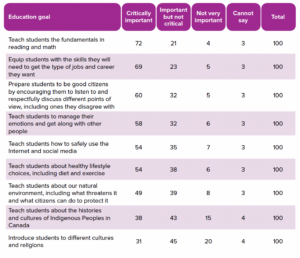
Relatively few Canadians say that any of these goals are not very important.
Generally speaking, the importance of these educational goals is ranked similarly across provinces. However, there are differences in opinion related to other factors. For instance, women are more likely than men to say that each of the goals is critically important. For example, 60% of women, compared to 48 % of men, believe that is it critically important for schools to teach students how to safely use the Internet and social media.
There are also differences in opinion by age. Older Canadians are more likely to say that teaching the fundamentals, and equipping students for jobs, are critically important. But younger Canadians are more likely to say that teaching about Indigenous Peoples, and about different cultures and religions, are critically important.
Chart 1: Critically important that public schools in your community do the following things
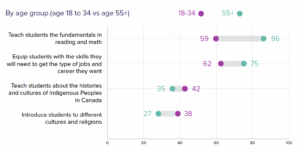
Source: Survey on Employment and Skills, W8 (March-April 2025). Created with Datawrapper
Introducing students to different cultures and religions is also more likely to be seen as critically important by racialized (41%) compared to non-racialized (27%) Canadians. Similarly, teaching students about the histories and cultures of Indigenous Peoples is more likely to be seen as critically important by Indigenous Peoples (56%) compared to non-Indigenous Canadians (36%).
The survey also asked Canadians to say whether public schools in their community are currently doing an excellent, very good, fair, or poor job in each of these areas. An average of 41 percent say that schools are doing either an excellent (14%) or a very good (27%) job (across the nine areas), and just under one in three (31%) rate school performance as fair. Fifteen percent say that schools in their community are doing a poor job, and an additional 13 percent do not give an opinion either way. In only one area does a majority of Canadians say that schools are doing an excellent or very good job: teaching students the fundamentals in reading and math (52%). It is notable that this also is the item that is most likely to be ranked as a critically important goal.
Table 2: School performance
Based on what you know or have heard, how good a job would you say the public schools in your community are currently doing in each of these areas? Are they doing an excellent, very good, fair, or poor job?
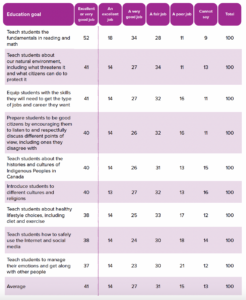
There is very little variation in the assessment of school performance in the other eight areas. The proportion saying that schools are doing an excellent or very good job ranges within a narrow range from a low of 37 percent in the case of teaching students to manage their emotions, to a high of 41 percent in the case of teaching students about our natural environment. While there is little variation overall, there are considerable differences between the responses of specific groups within the population.
Assessments of the performance of public schools vary significantly across provinces Quebecers are consistently more positive than other Canadians. The proportion of Quebecers who say that public schools in their community are doing an excellent or a very good job is higher than that in all other provinces in seven of the nine areas, and more or less equal to the highest province in the remaining two. The gap between Quebec and the rest of Canada is highest in the case of teaching students the fundamentals in reading and math: 65 percent of Quebecers say schools are doing an excellent or a very good job, compared to 48 percent in the rest of Canada, for a difference of 17 percentage points. The gap is greater than 10 points in the case of two other items: equipping students for jobs (+13 points), and teaching students how to safely use the Internet (+11 points).
Chart 2: Public schools in your community are currently doing an excellent or very good job
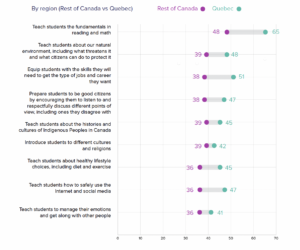
Source: Survey on Employment and Skills, W8 (March-April 2025). Created with Datawrapper
In several areas, the proportion of Quebecers who say that public schools in their community are doing an excellent or a very good job is about twice as high as the proportion in the least positive province. For instance, 48 percent of Quebecers say schools are doing an excellent or a very good job teaching students about our natural environment, compared to 25 percent in Saskatchewan.
Table 3: Public schools are doing an excellent or very good job (By province)
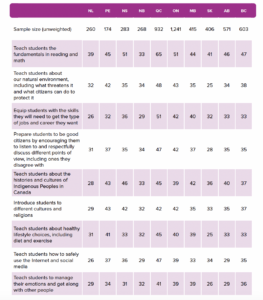
And based on what you know or have heard, how good a job would you say the public schools in your community are currently doing in each of these areas? Are they doing an excellent, very good, fair, or poor job? (Figures are the percentage of respondents in each province who say that public schools in their community are currently doing an excellent or very good job).
While Quebec stands out as the province where residents feel most positively about the performance of their schools, two provinces stand out as ones where residents often feel the least positive: Newfoundland and Labrador, and Saskatchewan.
Residents of Newfoundland and Labrador are the least likely to assess schools positively in four areas of the nine areas: teaching students how to safely use the Internet and social media (26%); equipping students with the skills they will need to get the type of jobs and career they want (26%); teaching students about the histories and cultures of Indigenous Peoples (28%); and introducing students to different cultures and religions (29%).
Residents of Saskatchewan are the least likely to assess schools positively in four other areas: teaching students about our natural environment (25%); teaching students about healthy lifestyle choices (25%); teaching students to manage their emotions (26%); and preparing students to be good citizens (28%).
In the case of teaching students the fundamentals in reading and math, however, it is New Brunswickers who are the most critical. Only 33 percent of that province’s residents say that public schools in their community are doing an excellent or very good job in this area.
Chart 3: Public schools are currently doing an excellent or very good job, by province

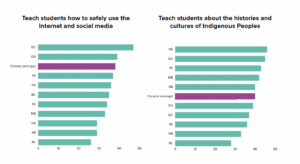
The questions were also asked in the three territories, though to a smaller number of respondents that does not allow results to be reported separately for each territory.1 Overall, the results show that residents in the territories are more likely than those in the provinces to rate each of the areas as critically important for public schools to do.
However, residents in the territories are less likely than those in the provinces to say that schools in their communities are doing an excellent or very good job in each of these areas, and more likely to say they are doing a fair job. One exception is the goal of teaching students about the histories and cultures of Indigenous Peoples, where residents in the territories are more likely than the Canadian average to say that schools are doing an excellent or very good job (57% compared to the average of 40%).
Positive assessments of the job public schools are doing are highest among younger Canadians and decline with age.
The difference between the proportion of those in the youngest (age 18 to 24) and oldest (age 55+) age groups who say schools are doing an excellent or very good job is greatest in the case of teaching students about the histories and cultures of Indigenous Peoples (a 24 percentage point gap) and introducing students to different cultures and religions (a 21-point gap). But there is a gap of at least 10 points for each of the nine items.
These gaps emerge in part because older Canadians are less likely to express an opinion either way. As age increases, the proportion that cannot say how good a job schools are doing increases as well. This is likely because older people have less recent direct contact with the school system, either as students or as parents of school-aged children.
In general, this increased uncertainty among older Canadians means they are less likely to say that schools are doing an excellent or very good job, but not more likely to say they are doing a poor job. However, there are two exceptions where the proportion saying schools are doing a poor job also rises with age: teaching the fundamentals in reading and math, and teaching students about the histories and cultures of Indigeous Peoples.
Chart 4: How good a job are public schools doing at teaching the fundamentals in reading and math (By age group)
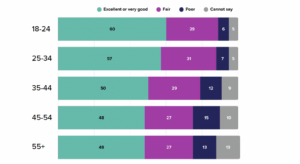
Chart 5: How good a job are public schools doing at teaching students about Indigenous Peoples? (By age group)
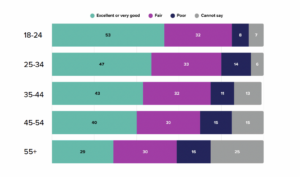
There are consistent differences across identity groups in the assessment of how well schools are performing in the nine areas covered in the survey.2 Generally speaking, both racialized Canadians and Indigenous Peoples are more likely than those who are neither racialized nor Indigenous (i.e. who identify as “white”) to say that public schools in their community are doing an excellent or very good job.3
Chart 6: Public schools in your community are currently doing an excellent or very good job (By racial or Indigenous identity)

Women have a slightly less positive assessment than men of school performance: in seven of the nine areas, the gap between the proportion of women and men who say that schools are doing an excellent or very good job ranges between four and six percentage points. While this gap is very modest in size, it is notable nonetheless given that women are more likely than men to say that each objective is critically important.
For instance, women (60%) are more likely than men (48%) to say that it is critically important that schools teach students how to safely use the Internet and social media. However, women (35%) are less likely than men (41%) to say that schools are doing an excellent or very good job in this area.
Another way to illustrate this difference is to look at the assessment of schools among those who believe a given objective is critically important. For instance:
Among those who say that teaching students how to safely use the Internet and social media is critically important, 51 percent of men compared to 37 percent of women say that schools are doing an excellent or very good job in this area.
Among those who say that teaching students to be good citizens is critically important, 46 percent of men compared to 38 percent of women say that schools are doing an excellent or very good job in this area.
Finally, the assessment of school performance is more positive among those with school-aged children in their household, compared to those of the same age without children.4
- Among those age 25 to 44 who have children in their household under the age of 19, an average of 52 percent say that schools are doing an excellent or very good job (across the nine areas mentioned in the survey).
- Among those age 25 to 44 who have no children in their household under the age of 19, only 35 percent say that schools are doing an excellent or very good job (across the nine areas mentioned in the survey).
Part of this difference can be explained by the fact that those without children are less likely to express an opinion either way on the performance of schools: the proportion of those in this age group without children who cannot say how schools are doing is over twice that of parents (an average of 13% compared to 5%). That said, those without children are still somewhat more likely to offer a negative assessment in most areas: an average of 18 percent say that public schools in their community are doing a poor job across the nine areas covered in the survey, compared with 13 percent of parents.
Generally speaking, it seems that having more direct contact with public schools in Canada – for those who have school-aged children in their household – is associated with more positive views of the how schools are doing.
Chart 7: How good a job are public schools in your community doing? (By age and children in the household)
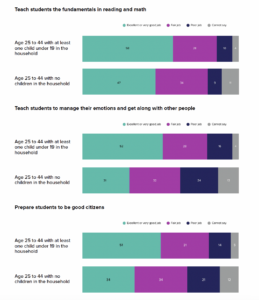
At a time when Canada faces profound economic, social, and environmental challenges, this report affirms public education’s vital role in shaping and supporting our collective future. The findings highlight that Canadians continue to place a high value on public schools, not only as institutions for academic achievement but also as spaces for civic development, emotional well-being, and preparation for the complexities of a rapidly changing world.
While Canadians recognize the strengths of our public education systems, they also express a desire for continued improvement. This dual message of confidence and concern suggests an opportunity to harness the full potential of public education as one of Canada’s greatest, yet under-leveraged, public assets.
The road ahead requires collaboration across sectors, regions, and generations, both inside and outside of education. It demands a renewed understanding of public education as vital infrastructure for a more equitable, resilient, and prosperous Canada.
The Survey on Employment and Skills is conducted by the Environics Institute for Survey Research, in partnership with the Diversity Institute at Toronto Metropolitan University and the Future Skills Centre. Wave 8 of the survey of 5,603 adult Canadians was conducted online (in the provinces) and by telephone (in the territories) between March 12 and April 15, 2025.
The questions covered in this report were developed in consultation with People for Education, an independent, charitable think tank working to support and advance public education through research, policy and public engagement. The Education Promise is an initiative of People for Education grounded in the belief that public education is one of Canada’s greatest assets for long-term resilience and prosperity.
For more details on the survey methodology as well as detailed results, visits the website of the Environics Institute at https://www.environicsinstitute.org/projects/listing/-in-tags/type/survey-on-employment-and-skills.
The Survey on Employment and Skills is funded primarily by the Government of Canada’s Future Skills Centre / Le sondage sur l’emploi et les compétences est financé principalement par le Centre des Compétences futures du gouvernement du Canada.
This report was authored by the Environics Institute for Survey Research, which is responsible for the accuracy of the content. The analysis and interpretations expressed in this report do not necessarily reflect the views of any of the other survey partners.
1Each question was asked of 294 respondents in the territories, except for the two items about teaching about Indigenous Peoples, which were asked of a larger sample of 450 respondents. Results for the territories, when presented separately, are unweighted.
2The survey asks participants to say which racial or cultural categories best describes them – the categories offered are the ones used by Statistics Canada in the census. The subsample sizes for the country’s three largest racialized groups – South Asian, Black, and Chinese – allow their results to presented separately when relevant. Results for other racialized
3 However, there is one exception to this pattern: among the largest racialized groups, those who identify as Chinese stand out as having a much less positive assessment. For instance, only 39 percent of those who identify as Chinese say that schools are doing an excellent or very good job at teaching students the fundamentals in reading and math, compared to 60 of those with any other racialized identity.
4 The survey asks about the presence of children in different age groups living in the household. It does not establish whether the person answering is the child’s or the children’s parent. However, it can be assumed that this would be the case in most instances involving adults age 25 to 44 with school-aged children in their household.
